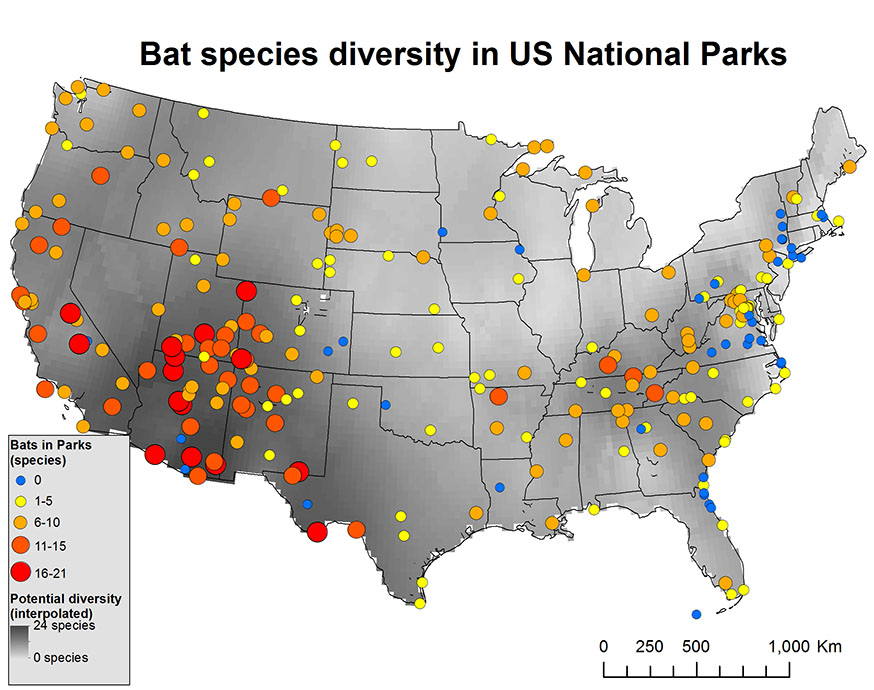News Release
You are viewing ARCHIVED content published online before January 20, 2025.
Please note that this content is NOT UPDATED, and links may not work. For current information,
visit https://www.nps.gov/aboutus/news/index.htm.

News Release Date: November 14, 2016
Fort Collins, CO—A new, first-of-its-kind study shows the National Park Service (NPS) is home to a whopping 53 unique species of bats, which is good news at a time when bats face tremendous threats. For the past decade, park staff and researchers have witnessed unprecedented declines in bat populations, spurring the need for a comprehensive review of bat species and habitats. The study highlights the high diversity of bats in the NPS as well as the need for more strategic conservation measures.“This is the first time we’ve had a complete view of all the bats in parks across the country. It’s really exciting because we have so many bats to celebrate—including as many as 21 species in Big Bend National Park—but it’s also sobering because of the huge responsibility we have to try and keep all those bats in parks safe,” said Tom Rodhouse, NPS ecologist and lead author of the paper.
For this study, Rodhouse combed through park bat records in NPSpecies, the service-wide database of all species’ status and occurrences, and compared those records to species range maps. He also studied how the spread of the bat disease white-nose syndrome (WNS), wind energy development, and climate change will affect bats in parks.
Published this week in Ecosphere, the paper A macroecological perspective on strategic bat conservation in the US National Park Service provides a comprehensive review of the many species of bats in parks and also of the important bat resources, like caves and abandoned mines, as well as the existential threats facing bats in parks.
The analysis uncovers gaps in data—places where certain species of bats are possible in a particular area but haven’t yet been documented. Equipped with this information, park biologists can focus their efforts in these areas and develop a more complete inventory of the species of bats and habitats used by bats in national parks. This approach offers opportunities for bat conservation in any park—not just the so-called “bat parks,” known for their large caves.
“I discovered that literally hundreds of parks are all dealing with the same challenges. For example, 10 years ago we thought widespread species like the little brown bat and the hoary bat were fine,” Rodhouse said. “Now, they’re suddenly facing extinction because of white-nose syndrome and wind turbine collisions.”
It’s crucial for park staff and researchers to know where bats live, hibernate, and migrate in order to protect them. Bats face many significant threats that are decimating bat populations all over the US. Wind turbines endanger migratory, tree-roosting bats; WNS, a fungal disease that affects hibernating, cave-dwelling bats has killed millions of bats since 2006; habitat loss, like deforestation or fragmentation, affects many species of bats; and climate change is a challenge for all bats because they are so sensitive to changes in temperature and water availability.
WNS is one of the most dangerous threats at this point. This summer, a bat sick with WNS was found in Washington near Mt. Rainier National Park. This discovery far out-paced predictions of WNS’ spread, and it further underscores the need for large-scale studies of bat populations and movements to better understand impacts of the disease and pathways of spread.
Threats to bats don’t respect boundaries, crossing from federal to state to private lands and often disrupting migratory paths. Bats themselves are also so wide ranging that bat conservation efforts will be most effective when done collaboratively across broad regions using similar methods. Parks can serve as places for study but will need to be part of larger partnerships in order to have the context to really understand how their bat populations are faring. This study helps the NPS make strategic investments in bat conservation and provides a baseline of bat diversity that can be used for future comparisons.
Visit nps.gov/bats to see this map that shows how many species of bats have been confirmed in individual parks, as well as parks that possibly contain bats that haven’t been documented. You’ll also find a complete list of bat species in national parks.
Read the full paper by Rodhouse et al. published on November 9, 2016.
Last updated: November 14, 2016
